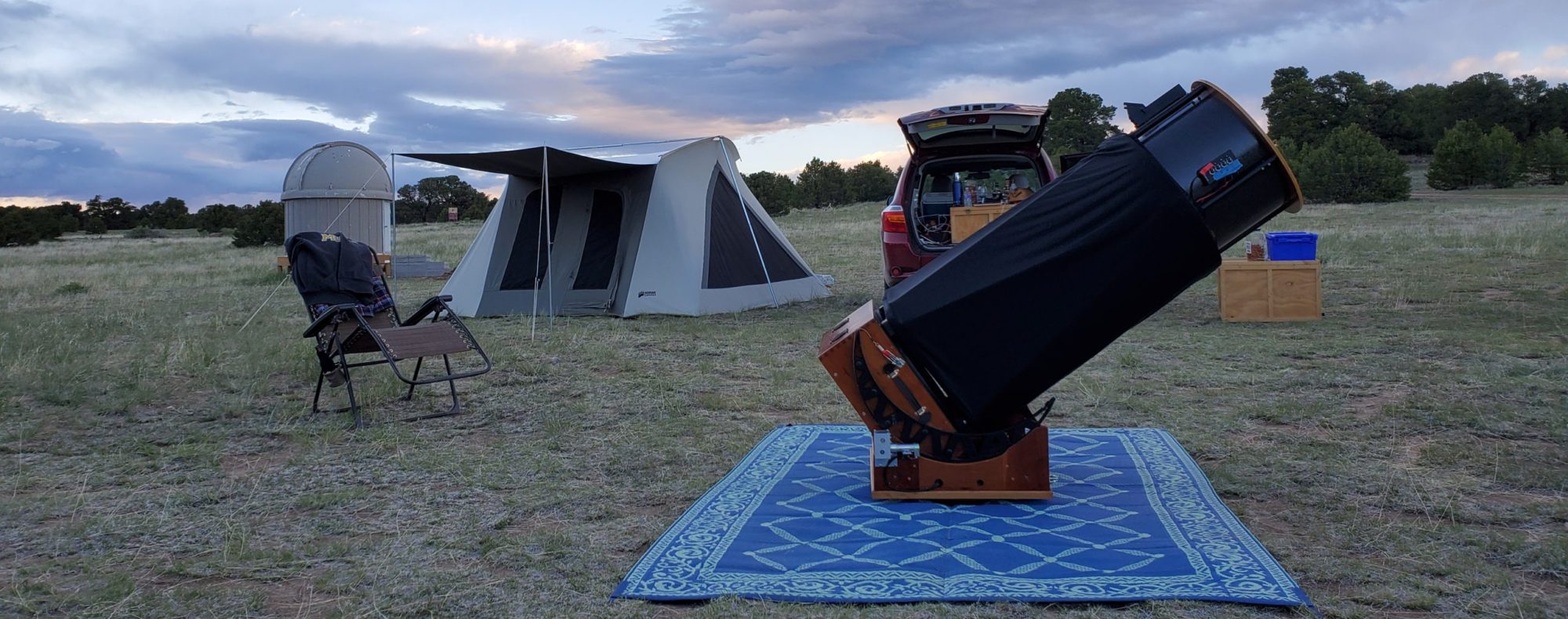Bentley and I have long considered doing a late-night observing session around first quarter. The problem being, the moon sets after we normally would warp up a long observing session. With very few opportunities to observe over the past two cycles, we made a game-time decision to do it. With a moon set of 1:08am CDT, I left home around 11pm, arriving in dark skies shortly after midnight. Time to eat drink astronomy!
eat
Given the late start, we didn’t have our usual spread at the bar, but that doesn’t mean we didn’t eat! After we packed up at 4:30am, I called ahead to our nearby Casey’s General Store, the only place open 24 hours for miles and miles, and ordered bacon, egg and cheese breakfast croissants. I know what you’re thinking…gas station food? But let me tell you, driving home at 5:15am is MUCH easier with a hot breakfast sandwich in hand. And if I’m being honest, I just might have stopped there earlier in the night before getting to the dark site to get two of their fresh baked cookies, monster and chocolate chip!
drink
Shortly after getting our scopes aligned and tracking, we went over to the ‘bar’ to see what we’d brought out. I had brought a bottle of the Ardbeg An Oa Islay scotch, and to my surprise, Bentley happened to bring out two other Ardbegs, the Uigeadail and the Corryvreckan. We tasted all three, with and without a splash of water to bring out the flavors, and we were most certainly not disappointed. All three of these scotches are extremely peaty, so beware of the smoke!
astronomy
Tonight I was observing with my NMT 18.5″ telescope and my set of TeleVue Ethos/Delos eyepieces; see my Equipment page for more details. I started off with an object in the Herschel II astronomy observing program, NGC 5056, which pairs nicely with dimmer NGC 5057. Viewed at 237x through my Delos 8mm eyepiece, this was a great object to start the night off on.

My observation notes were ‘Somewhat bright, clearly elongated N to S, small, bright mag 9 star 3.5′ away, some slight brightening near the core’. For NGC 5057, I noted it was small, dim, no real structure seen.
From there I looked at nearby galaxies NGC 5065 and PGC 46284, another close pair in Coma Berenices. I calculated the visual magnitude of 46284 to be ~15.16, slightly brighter than the stated VM of 15.52 in SkySafari 6 Pro. It’s the very small, dim galaxy below, left of center and down from NGC 5065.

Credit: wikisky.org
NGC 5065 was ‘Somewhat dim, dim mag 15 field star very close-by, only slightly elongated E to W but not obvious, even surface brightness, somewhat small, smaller and dimmer PGC galaxy in the view.’ Galaxy PGC 46284 is small, very dim, no structure visible, flutters in and out with averted vision.
Canes Venatici
I moved slightly NNE into Canes Venatici and observed a pair of very faint PGC galaxies, PGC 46368 and PGC 1942784, with the latter being one of the dimmest objects I’ve ever seen visually through any telescope! Here are my notes:
PGC 46368 – Very dim, small, no detail seen, paired with a similar sized but dimmer PGC very close by. SkySafari 6 lists its magnitude as 15.1, calculated as ~14.33.
PGC 1942784 – Extremely dim, in and out using averted vision only, not seen directly. SkySafari 6 lists it as magnitude 15.81, calculated to be ~15.06, but visually appeared slightly dimmer than PGC 46284.
My next target was NGC 5074, where I wrote ‘Somewhat bright, difficult to see elongation, fuzzy center with no obvious brightening, two dim PGC galaxies visible in the field.

Credit: wikisky.org
NGC 5074 – Somewhat bright, difficult to see elongation, fuzzy center with no obvious brightening.
PGC 46377 – Extremely dim, very small, averted vision only, shares field with much brighter NGC 5074. Listed in SS6 as magnitude 15.67, calculated as ~15.00.
Being that I was nearby PGC 46356, I was able to grab that one too. I noted it was dim, visible with direct vision, brighter core with averted, right by bright mag 12 star. SkySafari 6 lists it as magnitude 15.28, calculated as ~14.33.
IC Trio
Lastly, I took a look at a trio of IC galaxies; 4225, 4226 and 4227. I target IC galaxies often since most were first seen photographically versus visually, giving additional satisfaction in seeing them.

Credit: wikisky.org
IC 4225 – Somewhat dim, very elongated, somewhat edge on, small, nearby mag 13 star. Listed in SS6 as magnitude 14.97, calculated to be ~14.23.
IC 4226 – Small, fairly dim, concentrated, stellar core, round. Listed in SS6 as magnitude 15.11, calculated to be ~14.39.
IC 4227 – Dim, moderately sized, no shape or structure seen. Listed in SS6 as magnitude 15.54, calculated to be ~14.79.
Packing up on the ice covered parking lot was an added challenge. Although we usually only use red lights, even while packing up, an exception for white light was made for added caution. While this was a great, great night, it’s always sad to pack it up and see another astronomy observing session come to an end. Until next time…
